
The TGV is France's intercity high-speed rail service, operated by SNCF. SNCF worked on a high-speed rail network from 1966 to 1974 and presented the project to President Georges Pompidou who approved it. Originally designed as turbotrains to be powered by gas turbines, TGV prototypes evolved into electric trains with the 1973 oil crisis. In 1976 the SNCF ordered 87 high-speed trains from Alstom. Following the inaugural service between Paris and Lyon in 1981 on the LGV Sud-Est, the network, centered on Paris, has expanded to connect major cities across France and in neighbouring countries on a combination of high-speed and conventional lines. The TGV network in France carries about 110 million passengers a year.

The TGV Atlantique (TGV-A) is a class of high-speed trains used in France by SNCF; they were built by Alstom between 1988 and 1992, and were the second generation of TGV trains, following on from the TGV Sud-Est.

The SNCF TGV Réseau (TGV-R) trains were built by Alstom between 1992 and 1996. These TGV trainsets are based on the earlier TGV Atlantique.
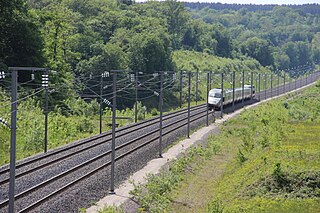
The Ligne à Grande Vitesse Est européenne, typically shortened to LGV Est, is a French high-speed rail line that connects Vaires-sur-Marne and Vendenheim. The line halved the travel time between Paris and Strasbourg and provides fast services between Paris and the principal cities of Eastern France as well as Luxembourg, Germany and Switzerland. The LGV Est is a segment of the Main Line for Europe project to connect Paris with Budapest with high-speed rail service.
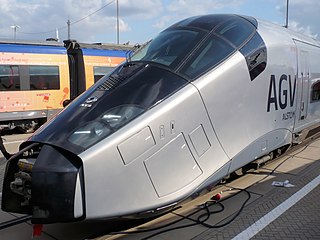
The AGV is a standard gauge, high-speed, electric multiple-unit train designed and built by Alstom.

The SNCF TGV Sud-Est was a French high speed TGV train built by Alstom and Francorail-MTE and operated by SNCF, the French national railway company. A total of 111 trainsets were built between 1978 and 1988 for the first TGV service in France between Paris and Lyon which opened in 1981. The trainsets were semi-permanently coupled, consisting of two power cars (locomotives) and eight articulated passenger carriages, ten in the case of the tri-voltage sets. The trains were named after the Ligne à Grande Vitesse Sud-Est that they first operated on. They were also referred to as TGV-PSE, an abbreviation of Paris Sud-Est.

The LGV Sud-Est is a French high-speed rail line which connects the Paris and Lyon areas. It was France's first high-speed rail line. The inauguration of the first section between Saint-Florentin and Sathonay-Camp by President François Mitterrand on 22 September 1981 marked the beginning of the re-invigoration of French passenger rail service.

The Thalys PBKA is a variant of the TGV POS high-speed trainset. It is operated by Thalys between Paris, Brussels, Cologne and Amsterdam, forming the abbreviation PBKA.

The TGV Duplex is a French high-speed train of the TGV family, manufactured by Alstom, and operated by the French national railway company SNCF. It is unique among TGV trains in that it features bi-level carriages. The Duplex inaugurated the third generation of TGV trainsets. It was specially designed to increase capacity on high-speed lines with saturated traffic. With two seating levels and a seating capacity of 508 passengers, the Duplex increases the passenger capacity. While the TGV Duplex started as a small component of the TGV fleet, it has become one of the system's workhorses.
The TGV is France's high-speed rail service. The idea of a high-speed train in France was born about twenty years before the first TGVs entered service. At that time, about 1960, a radical new concept was thought up; combining very high speeds and steep grades would allow a railway to follow the contours of existing terrain, like a gentle roller coaster. Instead of one or two percent grades which would be considered steep in normal applications, grades up to four percent would be feasible, thus allowing more flexible routing of new lines. Over the next several years, this very general idea gave rise to a variety of high speed transportation concepts, which tended to move away from conventional "wheel on rail" vehicles. Indeed, the French government at the time favoured more "modern" air-cushioned or maglev trains, such as Bertin's Aérotrain; Steel wheel on rail was considered a dead-end technology. Simultaneously, SNCF was trying to raise the speeds of conventional trains into the range 180 to 200 km/h for non-electrified sections, by using gas turbines for propulsion. Energy was reasonably cheap in those years, and gas turbines were a compact and efficient way to fulfil requirements for more power. Following on the TGS prototype in 1967, SNCF introduced gas turbine propulsion with the ETG turbotrains in Paris - Cherbourg service, in March 1970.
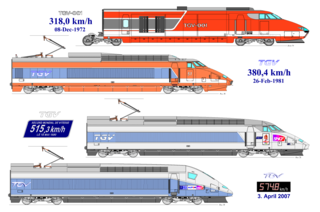
The TGV holds a series of land speed records for rail vehicles achieved by SNCF, the French national railway, and its industrial partners. The high-speed trials are intended to expand the limits of high-speed rail technology, increasing speed and comfort without compromising safety.
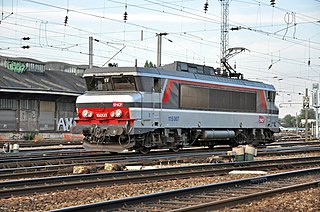
The SNCF class BB 15000 is a class of 25 kV 50 Hz electric locomotives built by Alstom and MTE between 1971 and 1978. Initially 65 locomotives strong, the series was widely used on the whole French 25 kV network before losing services to TGV trains when the LGV Est went into service in 2007.

TGV Lyria is the brand name used for TGV railway lines connecting France and Switzerland. Lyria is also a corporation that runs the service using the staff of the SNCF in France and Swiss Federal Railways (SBB CFF FFS) in Switzerland – the staff consists of one French and one Swiss train manager on the whole journey.

Operation V150, where 150 refers to a target speed in metres per second, was a series of high-speed trials carried out on the LGV Est. The V150 was a specially configured TGV high-speed train notable for breaking the world railway speed record on 3 April 2007. The train was built in France and reached a speed of 574.8 kilometres per hour (357.2 mph) on an unopened section of the LGV Est between Strasbourg and Paris, in France topping the previous record of 515.3 kilometres per hour (320.2 mph) set in 1990.

The first French high-speed rail line opened in 1981, between Paris's and Lyon's suburbs. It was at that time the only high-speed rail line in Europe. As of June 2021, the French high-speed rail network comprises 2,800 km of Lignes à grande vitesse (LGV).
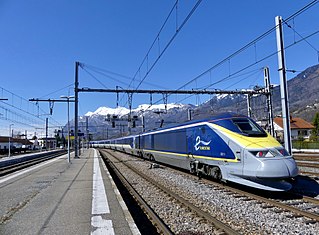
The British Rail Class 373 or TGV TMST, sometimes referred to as Eurostar e300, is a French designed and built electric multiple unit train that is used for Eurostar international high-speed rail services from the United Kingdom to France and Belgium through the Channel Tunnel. Part of the TGV family, it was built with a smaller cross-section to fit the smaller loading gauge in Britain, was originally capable of operating on the UK third rail network, and has extensive fireproofing in case of fire in the tunnel. It is both the second longest—387 metres (1,270 ft)—and second fastest train in regular UK passenger service, operating at speeds of up to 300 kilometres per hour (186 mph).
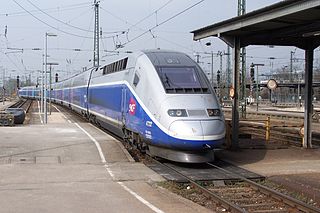
The Alstom Avelia Euroduplex, more commonly known as just Euroduplex, is a high-speed double-decker electric multiple unit train manufactured by Alstom. It is primarily operated by the French national railway company SNCF, and also in operation with the Moroccan national railway company ONCF. It is the 3rd generation of the TGV Duplex.

On 14 November 2015, a TGV train derailed in Eckwersheim, Alsace, France, while performing commissioning trials on the second phase of the LGV Est high-speed rail line, which was scheduled to open for commercial service five months later. The derailment resulted in 11 deaths among those aboard, while the 42 others aboard the train were injured. It was the first fatal derailment in the history of the TGV and the third derailment since the TGV entered commercial service in 1981.

IZY is a low-cost train service between Brussels and Paris. It is a brand of Thalys, which is jointly owned by the French and Belgian national rail companies SNCF (60%) and SNCB/NMBS (40%). It was announced on 1 March 2016, and the first services started on 3 April 2016.




















